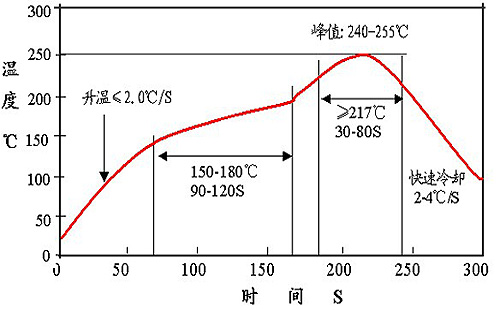Revealing the 4 major factors that affect the quality of SMT processing by reflow soldering
Reflow soldering, is the key process of SMT, reflow soldering process is coated with solder paste, placement of components of the PCB, after reflow soldering to complete the drying, preheating, melting, cooling and solidification of the welding process. In the welding process will often appear paste connect, paste standing and lack of paste welding or less paste welding defects, the reasons for this welding defects in addition to the reflow soldering process factors there are other external factors, the next reveal reflow soldering affect the quality of SMT processing 4 major factors.
I. PCB pad design
Reflow soldering quality and PCB pad design has a direct relationship. If the PCB pad design is correct, when the placement of a small amount of skew can be in reflow soldering due to the role of molten solder surface tension and get corrected (called self-positioning or self-correction effect); On the contrary, if the PCB pad design is not correct, even if the placement position is very accurate, after reflow soldering but will appear component position shift, hanging bridge and other welding defects.
II. Quality of the solder paste
Solder paste is an essential material for the reflow soldering process. It is a paste made of alloy powder (pellets) mixed evenly with a paste flux carrier. The alloy particles are the main component in the formation of the solder joint, while the flux removes the oxide layer from the soldering surface and improves the wetting properties. Ensuring the quality of the solder paste has an important impact on the quality of the solder.
III. Quality and performance of components
Components as an important component of SMT placement, its quality and performance directly affect the reflow soldering through rate. As one of the objects of reflow soldering, must have the most basic point is high temperature resistance. And some components will have a relatively large heat capacity, welding also has a big impact, for example, usually PLCC, QFP and a discrete chip components compared to the heat capacity to be large, welding large area components than small components more difficult.
IV, the welding process process control
1, the establishment of the temperature curveThe temperature profile is the curve of temperature change over time at a point on the SMA when the SMA passes through the reflow oven. The temperature profile provides an intuitive way to analyze the temperature variation of a component throughout the reflow soldering process. This is useful for obtaining optimum solderability, avoiding damage to the component due to overtemperature, and ensuring solder quality. The temperature profile is tested using an oven temperature tester, such as the SMT-C20 oven temperature tester.
2、Preheating section
The purpose of this area is to heat the room temperature PCB as soon as possible to reach the second specific target, but the rate of temperature rise should be controlled within the appropriate range, if too fast, it will produce thermal shock, the board and components may be damaged; too slow, the solvent evaporation is not sufficient, affecting the quality of welding. Due to the faster heating rate, the temperature difference in the temperature zone in the latter part of the SMA is large. To prevent damage to components from thermal shock, the maximum speed is generally specified as 4°C / s. However, the rise rate is usually set at 1-3°C / s. The typical rate of temperature rise is 2°C / s.
3、Insulation section
The holding section is the area where the temperature rises from 120°C-150°C to the melting point of the solder paste. Its main purpose is to stabilize the temperature of the components within the SMA and minimize the temperature difference. Sufficient time in this area so that the temperature of larger components to catch up with smaller components, and to ensure that the flux in the solder paste is fully volatilized. By the end of the holding period, the oxide on the pads, solder balls and component pins is removed and the temperature of the entire board reaches equilibrium. It should be noted that all components on the SMA at the end of this section should have the same temperature, otherwise into the reflow section will be uneven temperature of the various parts of a variety of bad welding phenomenon.
4、Reflow section
In this area, the heater temperature is set to the highest setting, so that the temperature of the component rises quickly to the peak temperature. The peak soldering temperature in the reflow section varies depending on the solder paste used, and is generally recommended to be the melting point temperature of the paste plus 20-40℃. For 63Sn/37Pb solder paste with a melting point of 183°C and Sn62/Pb36/Ag2 solder paste with a melting point of 179°C, the peak temperature is generally 210-230°C. The reflow time should not be too long to prevent adverse effects on the SMA. The ideal temperature profile is more than the melting point of the solder "tip area" to cover the smallest area.
5、Cooling section
This section of the solder paste within the lead-tin powder has melted and fully wetted the connected surface, should be used as fast as possible to cool, which will help to get a bright solder joint and have a good shape and low contact angle. Slow cooling can lead to more decomposition of the board and into the tin, resulting in gray and rough solder joints. In extreme cases, it can cause poor soldering and weaken the bonding of the solder joint. Cooling section cooling rate is generally 3-10 ℃ / s, cooling to 75 ℃ can be.

Reflow soldering is a complex and critical process in the SMT process, involving automatic control, materials, metallurgy and other deep science, the causes of welding defects are many, in order to obtain better welding quality, but also need to study in depth, and constantly in practice to summarize.






